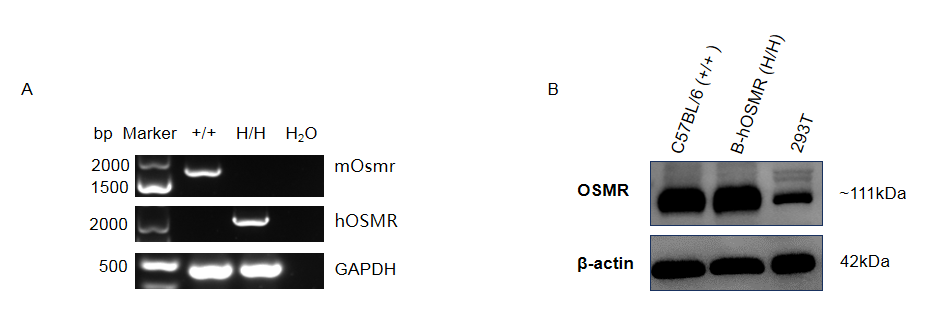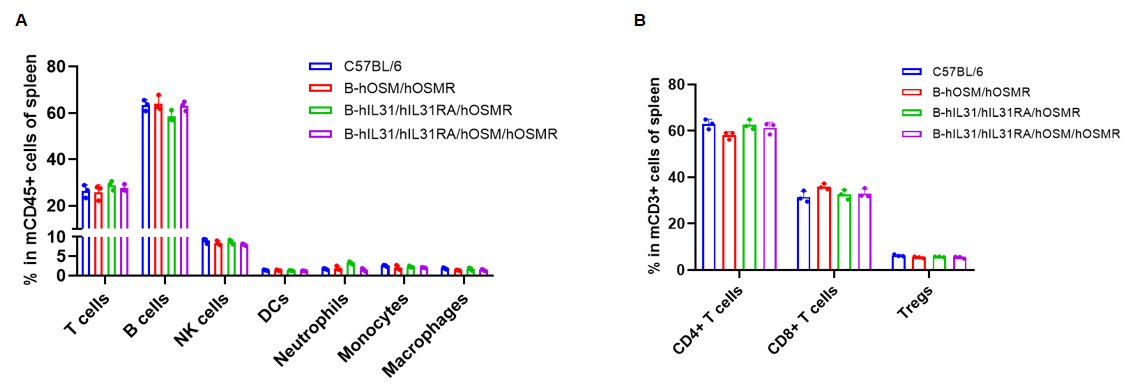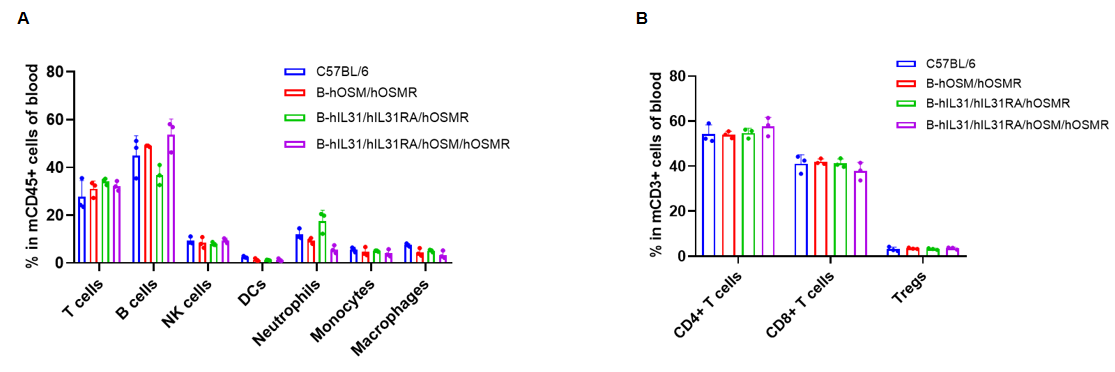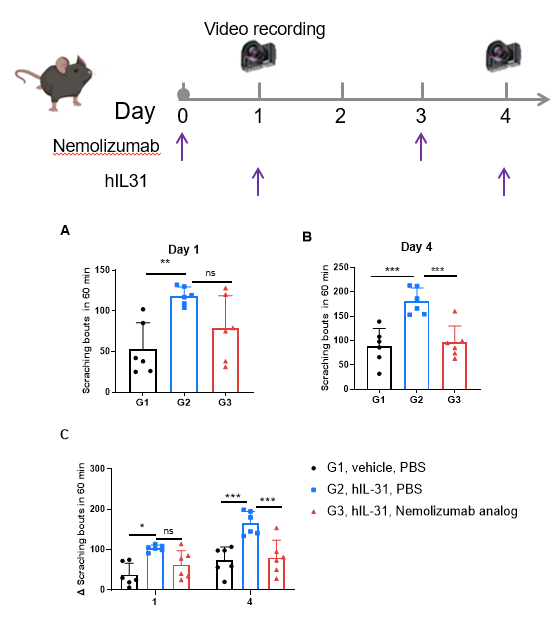


C57BL/6-Il31tm1(IL31)BcgenIl31ratm1(IL31RA)BcgenOsmrtm1(OSMR)Bcgen/Bcgen • 130746
| Product name | B-hIL31/hIL31RA/hOSMR mice |
|---|---|
| Catalog number | 130746 |
| Strain name | C57BL/6-Il31tm1(IL31)BcgenIl31ratm1(IL31RA)BcgenOsmrtm1(OSMR)Bcgen/Bcgen |
| Strain background | C57BL/6 |
| Aliases | IL31IL31RA (CRL; GPL; CRL3; GLMR; GLM-R; PLCA2; hGLM-R; IL-31RA; PRO21384; zcytoR17)OSMR (OSMRB; PLCA1; IL-31RB; OSMRbeta; IL-31R-beta) |
Gene targeting strategy for B-hIL31/hIL31RA/hOSMR mice. The mouse Il31 gene that encode the full-length protein was replaced by human IL31 counterpart gene sequences. The coding sequences including human IL31RA extracellular region and mouse Il31ra intracellular region were inserted into mouse Il31ra gene locus. The coding sequences including human OSMR extracellular region and mouse Osmr intracellular region were inserted into mouse Osmr gene locus.

Strain specific analysis of IL31 and IL31RA gene expression in wild-type mice and homozygous B-hIL31/hIL31RA mice by RT-PCR. Testis was collect from wild-type C57BL/6 mice (+/+) and B-hIL31/hIL31RA mice (H/H). Mouse Il31 and Il31ra mRNA were exclusively detectable in wild-type mice. Human IL31 and IL31RA mRNA were exclusively detectable in homozygous B-hIL31/hIL31RA mice, but not in wild-type mice.

Strain specific analysis of OSMR gene expression in wild-type mice and B-hOSMR mice by RT-PCR and western blot. (A) mRNA expression. Mouse Osmr mRNA was exclusively detectable in the kidney of wild-type mice (+/+). Human OSMR mRNA was exclusively detectable in homozygous B-hOSMR mice (H/H). (B) Protein expression. Kidney was collected from wild-type C57BL/6 mice (+/+) and homozygous B-hOSMR mice (H/H), and analyzed by western blot with anti-OSMR antibody. The OSMR protein can be detected in homozygous B-hOSMR mice.

Analysis of spleen leukocyte subpopulations by flow cytometry. Splenocytes were isolated from C57BL/6, B-hOSM/hOSMR mice, B-hIL31/hIL31RA/hOSMR mice and B-hIL31/hIL31RA/hOSM/hOSMR mice (n=3, 6 or 7-week-old, female, homozygous). Flow cytometry analysis of the splenocytes was performed to assess leukocyte subpopulations. (A) Spleen leukocyte subpopulations. (B) T cells subpopulations. Percent of T cells (CD8+ T cells, CD4+ T cells, and Tregs), B cells, NK cells, dendritic cells, neutrophils, macrophages and monocytes in B-hOSM/hOSMR mice, B-hIL31/hIL31RA/hOSMR mice and B-hIL31/hIL31RA/hOSM/hOSMR mice were similar to those in the C57BL/6 mice. Data was shown as mean ± SD, and analyzed using Ordinary one-way ANOVA method. (*p<0.05)

Analysis of blood leukocyte subpopulations by flow cytometry. Blood cells were isolated from C57BL/6, B-hOSM/hOSMR mice, B-hIL31/hIL31RA/hOSMR mice and B-hIL31/hIL31RA/hOSM/hOSMR mice (n=3, 6 or 7-week-old, female, homozygous). Flow cytometry analysis of the blood was performed to assess leukocyte subpopulations. (A) Blood leukocyte subpopulations. (B) T cells subpopulations. Percent of T cells (CD8+ T cells, CD4+ T cells, and Tregs), B cells, NK cells, dendritic cells, neutrophils, macrophages and monocytes in B-hOSM/hOSMR mice, B-hIL31/hIL31RA/hOSMR mice and B-hIL31/hIL31RA/hOSM/hOSMR mice were similar to those in the C57BL/6 mice. Data was shown as mean ± SD, and analyzed using Ordinary one-way ANOVA method. (*p<0.05)

Analysis of lymph node leukocyte subpopulations by flow cytometry. Lymph node cells were isolated from C57BL/6, B-hOSM/hOSMR mice, B-hIL31/hIL31RA/hOSMR mice and B-hIL31/hIL31RA/hOSM/hOSMR mice (n=3, 6 or 7-week-old, female, homozygous). Flow cytometry analysis of the lymph node was performed to assess leukocyte subpopulations. (A) Lymph node leukocyte subpopulations. (B) T cells subpopulations. Percent of T cells (CD8+ T cells, CD4+ T cells, and Tregs), B cells and NK cells in B-hOSM/hOSMR mice, B-hIL31/hIL31RA/hOSMR mice and B-hIL31/hIL31RA/hOSM/hOSMR mice were similar to those in the C57BL/6 mice. Data was shown as mean ± SD, and analyzed using Ordinary one-way ANOVA method. (*p<0.05)

Anti-hIL31RA antibodies attenuate the scratching behaviors in IL31-induced murine pruritus model. Human IL31 was administered to the B-hIL31/hIL31RA/hOSMR mice (female, 12-week-old, 6 mice/group) to induce the scratching behaviors. Meanwhile, the mice were treated with nemolizumab analog (in-house) or PBS. Scratching behavior was recorded on day 1 (A), day 4 (B).Summary of the mouse Itching frequency in different groups shown in figure (C). As shown, IL31-treated mice show significantly increased scratching bouts. In the nemolizumab analog treatment group, blockade of IL-31 signaling with anti-hIL-31RA antibodies significantly attenuates scratching behaviors on day 4. Values are expressed as mean ± SEM. Significance was determined by the 2way ANOVA. (*P < 0.05, **P < 0.01, ***P < 0.0001, ns: not significant)